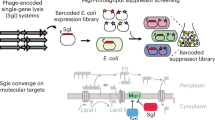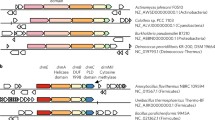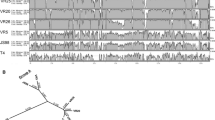Summary
Specific exclusion relations are know among the three Ustilago maydis viruses that are associated with the cytoplasmically transmitted ‘killer phemomenon’. Of the three viruses P1, P4 and P6, only P1, and P4 cancoexist in one host cell. Mutual exclusion occurs between P1 and P6 and P4 unilaterally excludes P6. The exclusion relations were originally defined among the wild-type viruses. Those relations can be modified by two specific segments that are a part of the P4 dsRNA genome and were also found in some sensitive strains that contained part of the viral genome. Also, deletion of the dsRNA segment that is assumed to encode the toxin information permits the formation of hybrid genomes that otherwise cannot be formed. The data is interpreted in terms of a dsRNA restriction modification system in which the killer toxin or a toxin-linked function acts as the restriction factor and segments H3 and H4 or H4 alone contain the necessary information for the modification of certain sites on the M and L segments of the P1 and P4 viruses but not on the P6 segments.
Similar content being viewed by others
References
Day PR, Anagnostakis SL (1971) Phytopath 61:1020–1021
Day PR, Anagnostakis SL (1973) Phytopath 63:1017–1018
Day PR, Dodds JA, Elliston JE, Jaynes RA, Anagnostakis SL (1977) Phytopath 67:1393–1396
Delbruck M (1945) J Bacteriol 50:151–170
Franklin RM (1966) Proc Natl Acad Sci USA 55:1504–1511
Hankin L, Puhalla JE (1971) Phytopath 61:50–53
Herring AJ, Beven EA (1974) J Gen Virol 22:387–394
Kandel J, Koltin Y (1978) Exp Mycol 2:270–278
Koltin Y (1977) Genetics 86:527–534
Koltin Y, Day PR (1975) Appl Microbiol 30:694–696
Koltin Y, Day PR (1976a) Proc Natl Sci USA 73:594–598
Koltin Y, Day PR (1976b) Genetics 82:629–637
Koltin Y, Kandel J (1978) Genetics 88:267–276
Koltin Y, Levine R (1979) Fungal viruses and killer factors — Ustilago maydis killer proteins. In: Molitoris HP, Wood HA, Hollings M (eds) Proc. Life Sciences. Springer, Berlin Heidelberg New York, p 120–128
Koltin Y, Mayer I, Steinlauf R (1978) Gen Genet 166:181–186
Koltin Y, Levine R, Peery T (in press) Mol Gen Genet.
Levine R, Koltin Y, Kandel JS (1979) Nucleic Acids Res 6:3717–3730
Peery T, Koltin Y (in press) Genetics
Puhalla JE (1968) Genetics 60:461–475
Russell RL, Huskey RJ (1974) Genetics78:998–1014
Stevens RB (ed) (1974) In: Mycology Guidebook, pp 506–524. University of Washington Press, Seattle, London
Streisinger G, Weigle JJ (1956) Proc Natl Acad Sci USA 42:504–510
Wood HA, Bozarth RF (1973) Phytopath 63:1019–1021
Author information
Authors and Affiliations
Rights and permissions
About this article
Cite this article
Koltin, Y., Levine, R. & Tamarkin, A. The exclusion among the Ustilago viruses — A dsRNA restriction modification system?. Curr Genet 2, 185–192 (1980). https://doi.org/10.1007/BF00435684
Received:
Issue Date:
DOI: https://doi.org/10.1007/BF00435684




